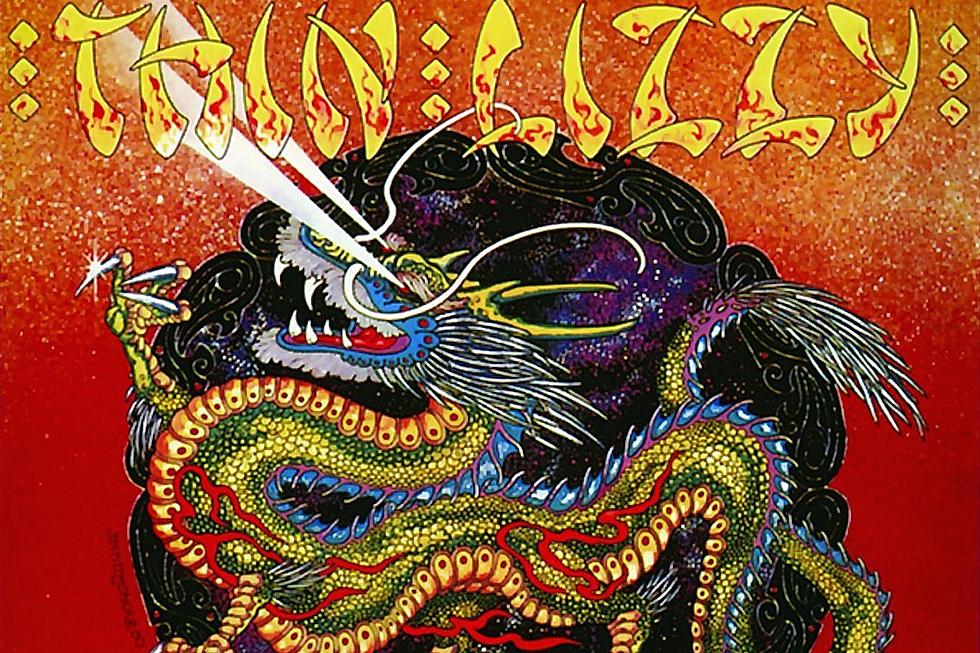
How Thin Lizzy Tried to Conquer Adversity With ‘Chinatown’
More so than almost any other band of their generation, Thin Lizzy had beaten the odds to attain considerable success throughout the '70s. But they would have to prove they could overcome recent troubles and distractions to be as a viable a proposition in the '80s – beginning with their 10th studio album, Chinatown, which was released on Oct. 10, 1980.
Indeed, even for a band as volatile by nature as Thin Lizzy, the previous few years had been filled with uncertainty and change – primarily where guitar players were concerned. Although vocalist and bassist Phil Lynott, drummer Brian Downey and guitarist Scott Gorham had formed a steady nucleus since 1974, the fourth member of Lizzy's "classic" lineup, guitarist Brian Robertson, had been dismissed in 1978 due to escalating personal and professional disagreements.
Then, his immediate successor, Gary Moore, lasted just one album (1979's excellent Black Rose) before tiring of Lynott and Gorham's hard-drugging ways and departing for a solo career. This forced the emergency hire of future Ultravox man (and Lynott pal) Midge Ure to fulfill touring engagements, and – if you want to be a stickler – the now long forgotten Dave Flett, who briefly expanded Lizzy into a quintet during their first Japanese tour.
Ure would also hang around to contribute to Lynott's first solo album, Solo in Soho, released in the spring of 1980. But, due to his prior commitments to Ultravox, Thin Lizzy would be forced to look elsewhere for a more permanent second guitarist with whom they could begin work on the aforementioned Chinatown, and their eventual choice was, to say the least, surprising.
His name was Terence Charles "Snowy" White and he was an experienced session player and sideman, boasting credits with Cliff Richard, Al Stewart, Peter Green, Cockney Rebel and, most recently, Pink Floyd, with whom he'd only just finished touring behind The Wall. White was also the first Englishman officially admitted to Thin Lizzy's historically multi-national lineup.
As White would later tell Lynott biographer Mark Putterford, "Although I wasn't perhaps the most obvious choice for Lizzy and I never made any promises about wearing studded belts and jumping around onstage, [Phil] was quite happy to have somebody who, as he put it, could be more of a musician." Another, as yet unofficial addition to the band was 17-year-old keyboardist Darren Wharton, who would immediately join the band on tour and in the studio, but not get credited but only made a full member for another year or so.
Listen to Thin Lizzy Perform 'Killer on the Loose'
As the spring of 1980 turned into summer, the retooled Thin Lizzy was busy honing their internal chemistry and testing new material out on the road (while simultaneously promoting Lynott's solo single, "Dear Miss Lonely Hearts"), and slipping into London's Good Earth studios to cut tracks for Chinatown. Among the tunes previewed to lucky U.K. audiences was the album's eventual, nasty, nasty title track, the anthemic "Sweetheart" and the propulsive "Sugar Blues" which became another showcase for the underrated Downey's formidable percussive skills.
Other new songs on Chinatown ranged from the rousing, mid-paced determination of opener "We Will Be Strong," the more carefree, acoustic-backed rocker "Having a Good Time" (another descendant of "The Boys are Back in Town"), the conversely dramatic "Genocide (The Killing of the Buffalo)" (featuring a particularly impassioned Lynott vocal), the heartbreakingly tender and regretful "Didn't I" and, finally, the rather iffy, half-reggae, half-forgettable amalgam of "Hey You."
But the album's piece de resistance was its menacing and sinister single, "Killer on the Loose," which caused quite a bit of controversy when certain media associated it to the ongoing furor across the British Isles over a serial killer known as the "Yorkshire Ripper," but nevertheless reached No. 10 in Britain and No. 5 in Ireland. Chinatown, meanwhile, performed well enough in the U.K. but not as well as recent efforts; it barely registered in the U.S. and didn't show much life even when the band descended there for a short tour, after wildly acclaimed passages through Japan, Australia and New Zealand.
And then, all of a sudden, it was time to move on from the Chinatown promotional cycle and look ahead to the next Thin Lizzy record, Renegade (1981), as well as Lynott's second solo LP, 1982's The Philip Lynott Album. Concurrently, there had arisen some of the predictable issues surrounding Snowy White's suitability for Thin Lizzy – not, mind you, for any purely musical reason but relating to his lack of performing charisma (Lizzy's road crew joked that they would have to stand in the wings prodding Snowy with broom sticks to make him move around).
All joking aside, though virtually every one of Thin Lizzy's albums sounds in some way spectacular, in retrospect, there's no denying that Chinatown had given the band a less-than-overpowering entry into the '80s. Within just four more years, another pair of studio albums (Renegade and 1983's Thunder and Lightning), and one more guitar hero recruited (former Tygers of Pan Tang and future Whitesnake hot shot, John Sykes), Thin Lizzy would be over and a drug-ravaged Phil Lynott accelerating ever faster to an early death in early 1986.
See Thin Lizzy Among Rock’s Most Underrated Albums
More From Ultimate Classic Rock









